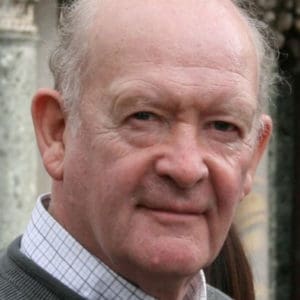Editor’s Note: David Torkington continues his series with a segue into the history of Christian Mystical Tradition, looking now at the beginnings of the monastic life and its influence in the Christian culture. To read part 29, see here. To begin with part 1, see here.
A Brief History of Christian Mystical Spirituality, Continued.
The love that was the mainspring of early Christianity was still enshrined in the monastic life after Constantine became emperor and Christianity was proclaimed the official religion of the Roman Empire by Theodosius the Great in AD 381. It was this consecrated form of life that was now used to renew the secular world that was rapidly going downhill.
The Plan for Renewal
The plan for renewal involved taking the spiritual life that was flourishing with ever greater fervor in the desert and using it as leaven to enable the secular world to rise from the decadence that threatened to destroy it. Far from being tainted with the laxity that was becoming endemic in the newly established Church, the nuns and monks in the desert were thriving, as whole armies of the young and the disillusioned were heading there to swell their ranks. They had not only heard about the exploits of these intrepid spiritual explorers by word of mouth, but they had read the Life of St Antony by St. Athanasius, the patriarch of Alexandria who had known Antony personally. Many had read the writings of John Cassian who had lived for twelve years amongst the monks in the Egyptian desert recording their ascetical heroism, and other writings that have remained with us to this day. Now they wanted to join them, so they flooded in droves to the monasteries founded by Antony, Pachomius, Macarius and others in Egypt, as well as to those founded by Hilarion, Jerome and Melanie in the Holy Land. So too the great monastic foundations in Cappadocia in present-day Turkey that thrived under St. Basil, St. Gregory Nazianzen and Gregory of Nyssa that drew their followers mainly from the Christian Eastern Church.
Beacons of Light in the Secular World
The plan to renew the Church was to encourage the monks to set up monasteries in the West on the edges of civilization or sometimes even in towns, to act like beacons of light to enlighten a secular world that was forgetting its origins. Important monastic foundations were set up in the south of France by monks including John Cassian and St Honorius and even in Rome itself, and other major cities of the Empire that were in desperate need of the spirituality of the Desert.
Then the next step was to choose the holiest and most learned of the monks and make them bishops, to inspire their clergy with the spirituality they in their turn would hand on to the faithful who were becoming all but spiritually destitute. When this new monastic breed of bishops found themselves alone in the world they were asked to re-evangelize, they felt isolated and insecure after the brotherly support they had received in their monastic seclusion. So, many bishops brought brother monks with them to their new surroundings to practice the way of life they had known.
The Coming of the Canons Regular
This inspired other bishops like St. Ambrose, St. Augustine and St. Martin of Tours to gather their clergy around them and introduce them to a sort of semi-monastic community for mutual support in turning to God and in ministering to the people. These priests who were not monks were nonetheless introduced to this semi-monastic way of life and came to be known as canons or canons regular because they were committed to a regular rule or canon that determined their way of life.
When these bishops built their Cathedrals, as well as building monasteries next to them, they set aside a place in their Cathedrals for the sort of monastic prayer they had enjoyed in the desert where some of them were formed. Choir stalls were built so that each member of the monastic or semi-monastic community could sit, kneel or stand opposite each other to recite the Divine Office. The structure of this Office was based on the Jewish tradition that Jesus and his disciples would have followed, praying five times a day. This practice was the origin of the Divine Office, as practiced in Benedictine Monasticism.
Benedictine Monasticism
This form of monasticism gradually became the most popular interpretation of monasticism in Europe in the sixth century, mainly due to its spirit of moderation. What was, however, the very essence of monastic spirituality was the profound prayer to contemplation that inspired and animated every other facet of the monastic life and the teaching that the monks used to inspire the secular world around them. This profound mystical spirituality can be seen in the writings of St. Augustine, as monastic spirituality begins to inspire those for whom the monks went into solitude in the first place. This same teaching can be seen alive and well and still inspiring monasticism two hundred years later in the writings of Pope St. Gregory the Great. Their profound mystical teaching can be read in detail in Dom Cuthbert Butler’s monumental book Western Mysticism. Quoting St. Gregory, he shows that above all else it is love that is central to the mystic way, for:
‘The gift of Contemplation can only be given to those who love, for the power of love is the engine of the soul, which while it draws it out of this world, lifts it on high.’
That it was still alive and intact at the end of what was a long and particularly depressing period in the Church’s history can be seen in the mystical theology of St. Bernard almost six hundred years later. Although monasticism as such was never specifically designed as an instrument to promote the Gospel message in the world, it was nevertheless remarkably effective. In addition to providing holy Bishops who imbibed the spirituality of the Desert Fathers, their monasteries became beacons of light in the Dark Ages to clergy and laity alike, disseminating both spiritual and secular learning, while transcribing the Christian and Pagan classics for posterity.
Western Mysticism by Abbot Butler
I think it important to remember that in his scholarly masterpiece Western Mysticism, Abbot Butler has shown that before St. Bernard (1090-1153), the inner or hidden awareness of God’s love that is experienced as a by-product of loving him, is generally called contemplation or mystical contemplation. This older and more traditional way of referring to the tangible experience of God’s love is generally retained by the mainstream of Catholic mystical writers. I use the word Catholic because genuine mystical writers who perpetuate the most ancient Christian mystical tradition are predominantly Catholic. The reason for this is that the first radical Protestant reformers, and those who are still influenced by their doctrines, believe that man is intrinsically evil thus making the divine indwelling and the consequent mystical life unthinkable. Anglicanism would, in general, be a good example of an exception to this rule. In her famous book Mysticism, Evelyn Underhill, an Anglican, admits as much when she says, ‘the greatest of mystics have been Catholic saints’ (p 126).
There is another great development of the monastic life that I must refer to because it had such a profound influence on the reconversion of Europe in the wake of the barbarian invasion, as well of course on the country where it grew and developed.
Antonian Monasticism comes to the West
I became bored with overindulging myself in the south of France many years ago. I, therefore, took the ferry to the island of Saint-Honorat a couple of miles off the coast of Cannes. It was here that more than fifteen hundred years ago, a community of monks arrived from the Egyptian desert. They were not just any monks, but monks who had been schooled in the monastic spirituality of their father Abbot Antony, described in detail by St Athanasius.
At the door to the now Cistercian monastery, there is a large plaque stating that it was here on this Island and from the monks recently arrived from Egypt, that St. Patrick was schooled in ‘the science of the spiritual life’. When he returned to Ireland it was to set up myriad monastic settlements after the style of the Antoninan monks. This is a central church around which the monks, or more precisely the anchorites, would build their primitive cells. The remains of such monasteries can still be seen in Ireland today and thanks to St. David in Wales and St. Juliot in Cornwall, at Tintagel for instance, high up on the headland above Merlin’s Cave. In his classic work Irish Monasticism the great Jesuit scholar Fr. Ryan describes their prayer life:
‘A very large proportion of the Irish monks progressed so far in prayer that they were capable of unbroken contemplation. Just as contemplation was looked upon as the normal result of a spiritual life, of self-conquest and prayer, so it was expected that some among the contemplatives would reach mystical heights in their Union with God.’
Spiritual Paternity
He then cites individual monks who like St. Antony before them would withdraw into greater solitude for ever deeper union with God. But this was not necessarily the end of their spiritual journey, for as St. Athanasius shows in his Life of Antony, the consummation of the spiritual life is in what he calls ‘spiritual paternity’. This spiritual paternity does not just prepare the monk to become a spiritual father to his own monks but to return to the world they left many years before to share the fruits of contemplation with others. That is why St. Athanasius tells us how before he died, St. Antony returned to the busy streets of Alexandria to preach to those in most need of the wisdom that he imbibed in his solitude. That is why it was the natural completion of their particular brand of monasticism for the Irish monks like Brendon, Columba and Columbanus and so many others, to set out and preach to the unconverted about what or rather Whom had converted them in their many years of solitary prayer.
Without such monks like Columbanus and his disciples, the new lands occupied by the ‘barbarians’ might never have been evangelized. If only present-day evangelists were prepared for the apostolate by contemplation, instead of by psychological gimmicks and crowd-pleasing novelties then, what was done for the Church in their day will be done again for the Church in our day.
Photo of Mont-Saint-Michel at sunset, Pixabay.





